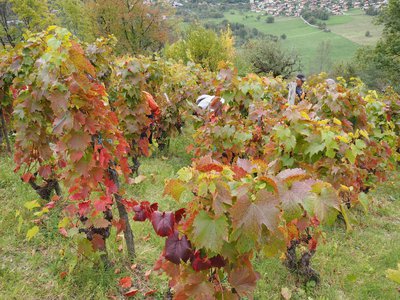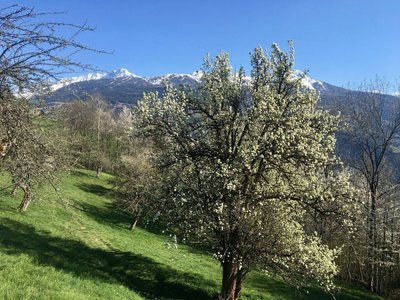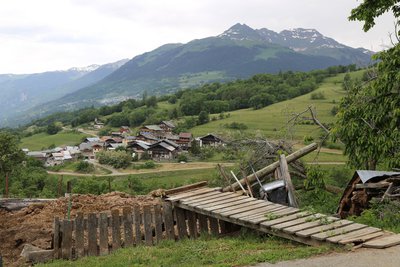Discovering the treasures of the Versants du Soleil

AIME-LA-PLAGNE
Discovering the treasures of the Versants du Soleil
Easy
3h
31,5km
+1176m
-1168m
Loop
Embed this item to access it offline
This itinerary takes you across the Tarentaise's justly famous Versant du Soleil , which boasts an unspoilt natural environment and is home to a mountain way of life that has never lost its authenticity. Set off in discovery of these still wild mountains, harbourers of little chapels, hamlets with their traditional local architecture, chalets set in high mountain pastures where livestock is left to graze undisturbed, and dense forestland. The views you’ll enjoy along the way are truly magnificent.
Description
Starting at the church in Aime, the itinerary takes you up to the Les Fours mountain pastures along a succession of little roads and tracks. You then make your way down again towards the village of Granier, via Pont des Lanches and the Tour of Beaufortin GR®. From Granier, the itinerary takes you down to Aime along a very pleasant little road.
Follow the blue waymarks: Les Versants du Soleil.
E-bike rental shop:
Bike Surgery
8 place Joux
73210 AIME
(Next to the church)
+33 (0)4 57 37 69 95
Follow the blue waymarks: Les Versants du Soleil.
E-bike rental shop:
Bike Surgery
8 place Joux
73210 AIME
(Next to the church)
+33 (0)4 57 37 69 95
- Departure : 73210 Aime, Place de l'Eglise
- Arrival : 73210 Aime, Place de l'Eglise
- Towns crossed : AIME-LA-PLAGNE and LA PLAGNE TARENTAISE
Forecast
Altimetric profile
Recommandations
Rando Vanoise has been designed to help you pick and choose your outings, but cannot be held liable where they are concerned. The mountain offers up a wide range of routes and trails for cyclists of all levels, but remember, it is a living, unpredictable environment and it is important that you head out suitably equipped. Ask advice from cycle rental operators.
If in doubt, you can take an introductory lesson in how to ride an electric bike with an instructor.
If in doubt, you can take an introductory lesson in how to ride an electric bike with an instructor.
If you see a herd ahead, slow down and go round it. If there is a patou, a guard dog, climb down from your bike and walk, pushing it alongside you. Avoid making any sudden or aggressive gestures towards the dog and move away from the herd slowly and calmly. The dog will only be checking that you do not pose a threat to its herd. Respect the parkland and close gates behind you after you've gone through them.
The mountain is living, please respect it by staying on the paths and tracks.
Transport
Rail service to Aime-la-Plagne.
Information: www.oui.sncf.com
Information: www.oui.sncf.com
Access and parking
From Albertville, take the RN90 towards Bourg-Saint-Maurice until you get to Aime.
Parking: Place de l'Eglise
Parking: Place de l'Eglise
Parking :
Place de l'Eglise 73210 Aime
Accessibility
- Emergency number :
- 114
10 points of interest

Les vignes - aptv_redac  Flora
FloraThe vineyards (information panel)
Much of the Versant is taken up by vineyards, laid out up to an altitude of 800 metres. A modern press (2012) on the ground floor of La Côte d'Aime’s presbytery plays its part in the elaboration of a top-quality wine, enabling winegrowers to produce up to 120 hectolitres. The Vignes de Tarentaise association makes the press available to motivated “neo-vignerons” (newcomers to the art of winegrowing) and old hands alike. And there’s also a pasteuriser and pump for locals who produce…fruit juices! A QR Code links you to the “Patrimoine de La Plagne Tarentaise” website on the municipality’s heritage.
 History
HistoryHamlet of Le Villard
Just like all the other villages, Le Villard had its own chapel long before its attachment to the parish of La Côte d’Aime. Dedicated to Saint Blaise and Saint Anne, it is a very old edifice. We don’t know exactly when it was built.
 History
HistoryChef-lieu of La Côte d'Aime
La Côte d’Aime’s church, located on Les Chemins du Baroque (https://www.savoie-mont-blanc.com/Decouvrir/Explorer/Culture-et-patrimoine/Les-Chemins-du-Baroque), was built between 1702 and 1714 and is dedicated to Saint Lawrence. It was previously known as the church and parish of Saint Amédée de la Côte, in honour of the first Patron Saint of La Côte, even though he was never actually canonised. A painting commissioned by the parishioners in his honour adorns the high altar. Very few major changes have been made to the church since it was built, apart from the bell tower, which once had four smaller crosses at each corner. The bells themselves were used to make cannons during the French Revolution. The Notre Dame de Pitié (Our Lady of Mercy) Chapel near the town hall was built in 1821 and is well worth a visit. It stands on the site of a small oratory dedicated to Notre-Dame de Pitié, which existed as far back as 1630. It’s possible that it was built in that year, at the time of the Great Plague, on the spot known as “le creux des morts” (hollow of the dead). In fact, there used to be a cemetery here for plague victims.Restoration work on the chapel was last carried out in 1967, by the Italian painter Dalessandro. The paintings on its exterior depict Saint Yves and Saint Peter on the left, and Saint Mamert and Saint Paul on the right. Saint Mamert is invoked as protector of harvests.
The former cheese dairy, which closed its doors in the 1970s, now houses a little museum containing exhibits connected with the traditional art of cheesemaking and life as once lived in the mountain pastures and villages. A film gives you some idea about how Beaufort is made. Cheese sold onsite.
The village also boasts a reconstruction of an early 20th-century classroom, containing all the materials and furniture that made up the daily lives of the schoolchildren in those long gone days.Information on opening times from La Côte d’Aime’s Tourist Office: Tuesdays, Thursdays and Fridays, from 4 p.m. to 6:30 p.m.
04.79.55.69.25./ 07.66.09.78.94
Hameau de Prébérard - aptv_redac  History
HistoryHamlet of Préberard
There is very little archive material on this hamlet. Its name is of Germanic or Burgundian origin: Pra / pré (grassland/ pasture) and the name Béraldi evolving into bérardi / bérard. The archives only tell us that an oratory dedicated to Sainte Apollonia existed at the top of the village and there is also mention of “Pré Bérard d’Amont”. Houses were built alongside the road to Les Bergeries, and a few of their walls still stand. They were probably destroyed by fire. Another village, Salignon, of which little trace remains, was built on the approach to the crossroads of the same name, between Pré Bérard and Pré Girod. A few walls remain, visible in the midst of the trees.
A QR Code provides a link to the Patrimoine de La Plagne Tarentaise website on the area’s heritage.
Les vergers - aptv_redac  Flora
FloraOrchards
The Versant is planted with a good many orchards, and apple trees made a significant contribution to its prosperity up until a few decades ago. Members of the Croqueurs de Pomme (Apple Munchers) association are now helping to bring them back to life again. The association was founded in 2004 following growing concern about the abandonment of the Valley’s traditional orchards. Its aims include protection of old fruit varieties and landscape heritage, transmission of knowledge and knowhow, and development of an informal economy based on collection of local apples and manufacture of apple juice and other by-products.
Hameau de Montméry - aptv_redac  History
HistoryHamlet of Montméry
The style of its houses and form of its alleyways make Montméry a typical mountain village. Take the time to admire its arched doorways and traditional houses, and to seek out the venerable inscriptions sometimes found on beams supporting their finely-wrought frameworks, along with its well-preserved sundials and “bachals” (water troughs).It has also long been a centre for painters and woodcarvers.
Here too is the house that once belonged to Joannès (A QR Code links you to the Patrimoine de La Plagne Tarentaise website), a bygone inhabitant of the village whose mission it was to breathe new life into the objects that had marked his and his parents’ and grandparents’ childhoods. Immerse yourself in the atmosphere of a house from days long past where humans and animals lived together in harmony. Everyday objects, furniture, work tools, and more besides… testimonies to the lives of the people who lived there in the early days of the last century. Surroundings that provide a better understanding of how life could be both simple and difficult at the same time, and also make us realise how much life has changed between then and now.
Montméry’s little cheese dairy keeps all its materials on show in a perfect state of preservation, from the fine copper cauldron used in the making of Beaufort cheese to the little notebooks where the weight of milk delivered by each producer was entered.
Montméry has two chapels, the larger being Saint Etienne Chapel, while Saint James Chapel stands like a sentinel over the hamlet, visible from a good distance away.
And last but not least, an orientation table is on hand to help you take in the fine views of the mountain peaks to best advantage.Guided tour of the hamlet, Joannès’ house and the cheese dairy on Tuesdays and Thursdays from 3:30 p.m. to 4:30 p.m., upon reservation at the Tourist Office.
04.79.55.69.25./ 07.66.09.78.94
Eglise Saint François de Sales dans le village de Valezan - aptv_redac  History
HistorySaint-François-de-Sales Church - Valezan
This church harbours an impressively sized altarpiece in various shades of beige. A gilded timber tabernacle from Italy is given pride of place. Statues of four evangelists as well as St Francis de Sales and St Felix above can be seen in recesses. There are fifteen medallions on the Rosary altarpiece. A decorated rood beam, adorned with cherubs, can be seen at the chancel entrance. There is also an 18th century timber statue on the right-hand pillar.
Open on Wednesdays from 15:30 to 17:30, in July and August.
Free
Tel.: +33 (0)4 79 07 66 41
 History
HistoryVillage of Valezan
A traditional little mountain village nestling on the slopes of the Versant du Soleil 1,200 metres above sea level, Valezan enjoys full southern exposure and remarkable views. Its way of life has changed little and still largely depends on agriculture. With some 200 inhabitants all year round, it has a small school and an inn that is the centre of community life. The village’s inhabitants also produce Beaufort cheese and Genepy liqueur, and breed livestock.
Notre Dame de Lourdes Chapel is located to the east of the village. It was built in 1881 on the aptly named Chemin des Chapelles. It contains two paintings of Our Lady of La Salette, as well as paintings of Saint Roch and Saint Genevieve in memory of two other chapels now disappeared.
The upper part of the village also contains the Baroque-style Saint Francis of Sales Church, built between 1727 and 1730. Its furnishings testify to the villagers’ religious zeal in the early 18th century, as well as to the village’s prosperity. It is located on Les Chemins du Baroque (https://www.savoie-mont-blanc.com/Decouvrir/Explorer/Culture-et-patrimoine/Les-Chemins-du-Baroque).Saint Francis de Sales Church: open on Thursday from 3 p.m. to 5:30 p.m. A QR Code provides a link to the Patrimoine de La Plagne Tarentaise website
 Pastoralism
PastoralismLes Fours’ montagnettes
Set in unspoilt natural surroundings of grassland and forests, the hamlet of Les Fours is notable in particular for its montagnettes, a typical feature of mountain life. The term is commonly used to refer to temporary dwellings with provision for livestock, located above a municipality’s villages. In bygone days, they provided shelter for farmers, who occupied them in the springtime along with their animals before going up to the high mountain pastures and in the autumn when they came back down again.
The hamlet has preserved its traditional architecture and customs rooted in the past, with most of its inhabitants making their livings from agriculture. Keep your eyes open, as the panorama is well worth going out of your way to see!
 Pastoralism
PastoralismLes Bompas’ montagnettes
Another hamlet and its typical mountain chalets. Keep an eye out for the house that once belonged to the Arpenteux – that’s what the inhabitants called the forbear who built this particular chalet… He was the village’s surveyor.
